Common dimensions
Concept of 5th and 95th percentileIt is conventional to refer to the 5th percentile (short) female and the 95th percentile (tall) male to establish a range of human dimensions that accommodates 90% of the population. For individuals outside this range (i.e. very tall or very short people), design for the specific individual. The illustration at right shows both stature and elbow heights for the 5th percentile female and the 95th percentile male. Anthropometry tables provide equivalent data for a large number of other dimensions: hand width, knee-to-tailbone length, sitting overhead reach, etc. |
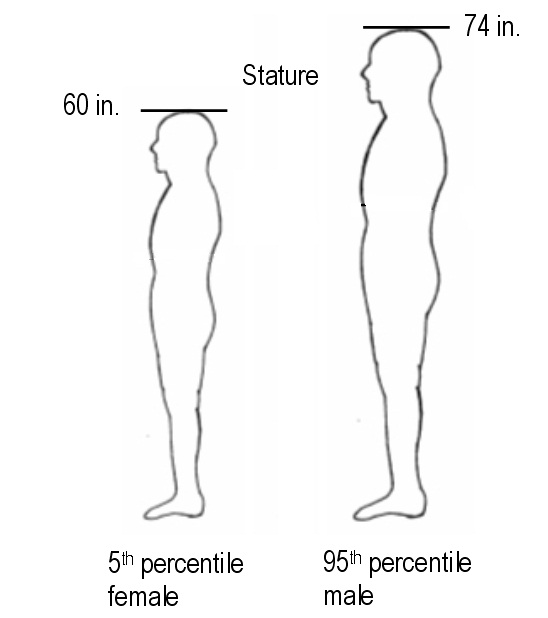 |
Working heightElbow height range: 37–47 in. A range is often used to accommodate both tall and short people. For example, as shown in the illustration at right, elbow height for the 5th percentile female and the 95th percentile male is 37 inches and 47 inches respectively. Thus, a workbench or a standing platform that adjusts 10 inches accommodates 90% of the population. |
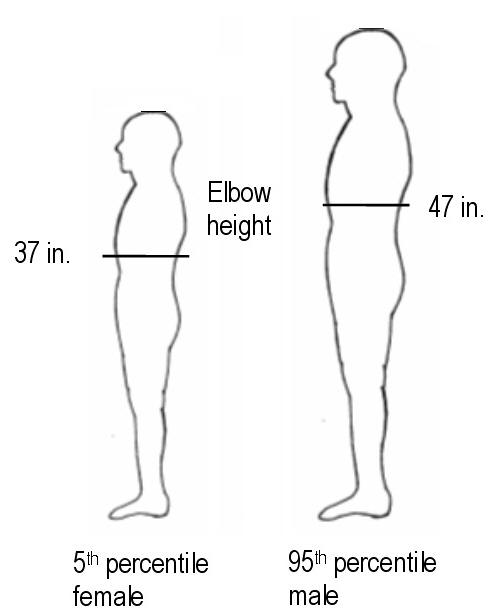 |
| It is sometimes not possible to accommodate a range. In these cases, as a fallback, average elbow height can be used, i.e., the 50th percentile. For a mixed male/female population, this dimension is 41 inches. |  |
| Likewise, it is not possible to always create a working height at elbow level. Consequently, an additional fallback guideline is to at least keep the work below shoulder height and above knee height. The 5th percentile female is used to set shoulder height, i.e., 49 inches. The 95th percentile male is used for knee height, i.e., 24 inches.It is common to refer to heights at approximately elbow height as the “green zone.” Heights above the shoulder and below the knees are in the “red zone” and the levels in between red and green are the “yellow zones.” |  |
ReachStanding overhead grip: 71 in. Reach distance is usually established by using the 5th percentile female for a given dimension. The concept is that if a short person can reach, then everyone can reach. Note that the distance to the hand is often set for functional reach, that is, the midpoint of the hand rather than the fingertip. The distinction is that often one must do something with an object, not just touch it. Sometimes touching is all that is required, such as pushing a button. In this case, using fingertip reach is satisfactory. |
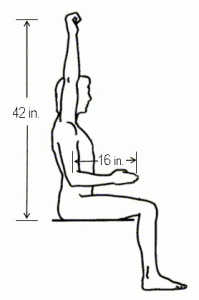 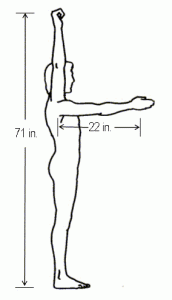 |
ClearanceTailbone-to-knee: 26 in. Clearance is typically set by using the 95th percentile male for a given dimension. If the tall male can fit, so can everyone. |
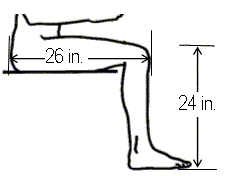  |
Anthropometry Tables
Full anthropometry tables usually provide a large number of measures, with data reported as the mean and standard deviation, as well as the 5th and 95th percentiles for both males and females.
For the full data set from which the above measures are taken, see either:
Pheasant, S., 1996. Bodyspace: Anthropometry, Ergonomics and the Design of Work, Second Edition. Taylor and Francis.
MacLeod, D., 2012. The Rules of Work: A Practical Engineer’s Guide to Ergonomics, Second Edition, Taylor & Francis. (Reprint of the basic industrial data from the Pheasant text.)
For further details and explanations, including data from additional populations around the globe, infants, the aged, and various additional measures, see the Pheasant text. Many additional sources are also available.
Common Pitfalls
Several important factors can affect decisions when choosing and using anthropometric data and interpreting results:
The Task
The most common factor that affects anthropometry is the nature of the task. For example, the optimal height for most work is approximately elbow height, which is easily found in the tables above. But heavy tasks are usually done best below elbow height (in order to maximize exertion), while precision work is generally best performed above elbow height (in order to see). Consequently, one must adjust the data for these differences, which usually requires that designers be familiar with the task. Sometimes, testing with experienced employees is needed.
Size of tools and products
Dimensions of any additional tools or products used in the task may also affect your choice of data. For example, when working on a tall item, the height of a work bench or conveyor line should be lowered accordingly.
Clothing
The data do not include the effect of clothing such as hard hats, boots, heels, gloves, and heavy winter clothing. The data need to be adjusted for clothing of this type.
Workforce differences
The workforce in a particular facility may differ from the population base from which the data were obtained:
- Age
- Ethnic background
- General, industrial, or military populationss
